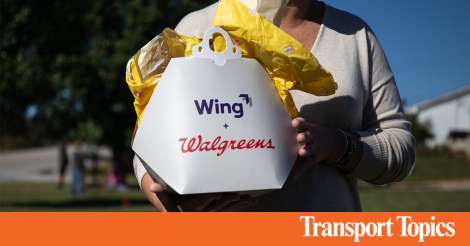
A customer opens a package delivered by a Wing Aviation drone at their home. (Logan Cyrus/Bloomberg News)
[Stay on top of transportation news: Get TTNews in your inbox.]
Dallas-area residents will get to experience a milestone in drone delivery next month when companies including Alphabet Inc.’s Wing Aviation navigate the same airspace to carry small packages straight to people’s homes.
The Federal Aviation Administration has cleared Wing and Zipline International Inc. to fly their drones simultaneously over the suburbs of Dallas and Fort Worth, Texas, without visual observers, using technology to manage traffic and keep the drones apart. The agency expects initial flights using the drone-traffic system to begin in August and that it’ll issue approvals to additional companies in the near future.
“It’s something that’s scalable nationwide,” Paul Fontaine, an FAA assistant administrator responsible for overseeing the modernization of the air transportation system, said in an interview.
The development is a first for U.S. aviation, according to the FAA, and seeks to overcome a major obstacle that has held back drone delivery. Drones promise a faster and more climate-friendly alternative to delivery using traditional modes of transportation like vans and can be used to bring critical supplies such as medicine to remote areas. Critics, meanwhile, have raised concerns about privacy, noise pollution and safety as the drones navigate increasingly congested skies.
In a first for U.S. aviation, the FAA has authorized @Zipline and @Wing to operate drones beyond visual line of sight in the Dallas area, using technology that allows them to deliver packages while keeping drones safely separated. Learn more at https://t.co/LDRLu0ofoG. pic.twitter.com/UFuq1Iue8r
— The FAA ✈️ (@FAANews) July 30, 2024
The number of drones in the U.S. are expected to rise sharply in coming years. The FAA projects the total registered units could surpass 3 million by 2028 from the more than 782,000 registered as of June 2024, of which almost half are for commercial use.
As part of this latest step, the industry will be responsible for managing the airspace using a system that enables companies to share data and planned flight routes so that their drones don’t collide. It’s the first time operators can use it for real-world deliveries, with the FAA providing oversight for safety.
A drone carries a bag of goods from Walmart. (Walmart Inc./TNS)
“In order for you to actually have drones delivering things to your house and just flying around the way people imagine it, you’re going to have to keep them apart,” said Jeffrey Vincent, executive director of unmanned aircraft systems integration at the FAA.
Vincent said the latest milestone is one of the most significant, after several companies, including Wing, UPS Inc.’s UPS Flight Forward, Amazon.com Inc.’s Prime Air, and Zipline, received exemptions from the regulator to fly drones in certain parts of the U.S. without someone on the ground having to physically keep them in view.
UPS Inc. ranks No. 1 on the Transport Topics Top 100 list of the largest for-hire carriers in North America. Amazon ranks No. 1 on the Transport Topics Top 100 list of the largest logistics companies in North America and the global freight companies list, and No. 9 on the private carriers list.
The ability to fly in the same airspace and use the traffic-management system will help eliminate barriers companies face when choosing U.S. cities to operate in, said Okeoma Moronu, global head of aviation regulatory affairs at Zipline, which partners with retailers, such as Walmart Inc., as well as health care facilities and restaurants. The company, which is launching its operation in the Dallas area soon, has made more than 1.1 million commercial deliveries worldwide.
Walmart ranks No. 2 on the private carriers list.
Prior to the approval, operators either had to fly in different areas or pilots had to call each other if they thought a route might overlap.
“It means that you can really look at where are the businesses we want to partner with and the customers we want to serve, and we don’t have to be worried about who else is already there,” Moronu said in an interview.
Having a more automated system for companies to share flight data is important for the industry to grow, said Margaret Nagle, head of policy, regulatory and community affairs at Wing, which also partners with Walmart as well as the online food delivery service DoorDash Inc.
According to the FAA, companies began testing the drone-traffic system in the Dallas area in 2023 — first with simulations and then with live runs. All of the drones fly below an altitude of 400 feet, away from crewed aircraft. The operators conducted thousands of flights before the agency approved them to fly in the same airspace, the FAA said.
The real-world deployment of the technology offers a chance for the U.S. to move ahead after spending years playing catchup with other parts of the world, including Europe, said Amit Ganjoo, CEO of ANRA Technologies, which is providing traffic management services to Irish drone delivery startup Manna.
“This gives the U.S. an opportunity to leapfrog in a sense,” he said.
At the same time, the operations in the Dallas area will help inform the next major milestone for the industry — proposed regulation on drone flights beyond visual line of sight that the FAA plans to release later this year.
The rule will eliminate the need for companies to rely on a patchwork of special waivers and exemptions to operate, said John Vernon, the co-founder and chief technology officer of DroneUp, a drone delivery company in which Walmart has invested.
“We’re starting to clear away obstacles and move in a direction that’s hugely beneficial for drone operators,” he said.